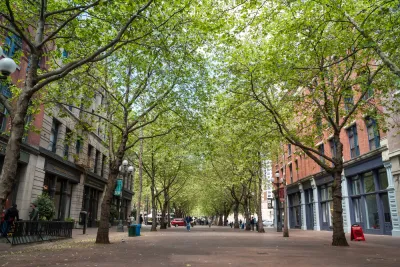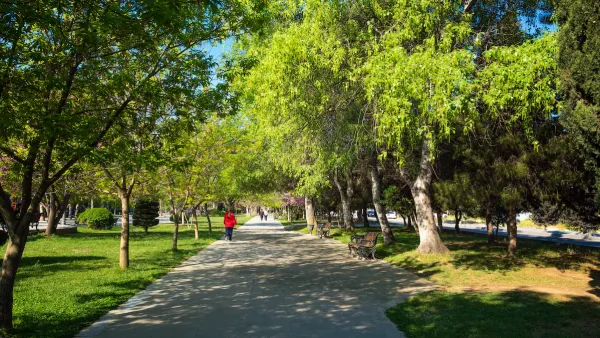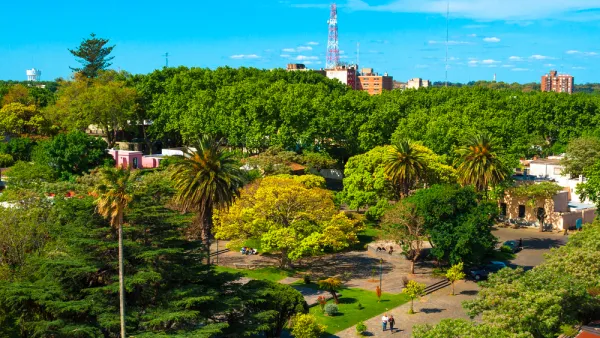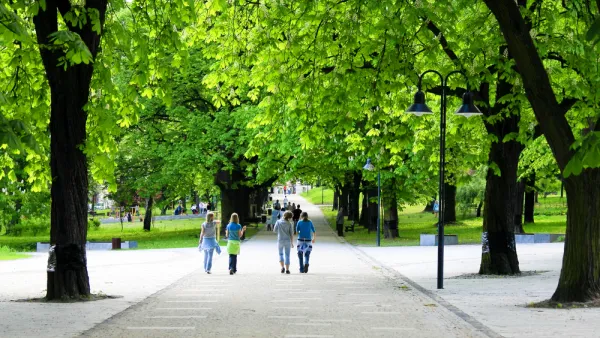As climate change intensifies the urban heat island effect, poorer neighborhoods bear the brunt of tree canopy inequity.

"There are certain visual clues that identify the socioeconomic status of an urban neighborhood," writes Natalie Bicknell, "and in the United States one of these is the presence — or absence — of trees." In order to achieve equity in tree canopy coverage, U.S. cities should plant 522 million trees in urban areas, according to a new tool called the Tree Equity Score (TES). "Combining GIS (Geographic Information System) mapping data with information provided by the United States census on population density, demographics of residents, health trends, and urban heat indexes, the TES uses quantitative analysis to determine whether locations have enough trees to provide optimal health, economic and climate benefits to residents."
An assessment of TES data shows that "[o]n average, American neighborhoods home to a majority of people of color have 33% less tree canopy than majority White neighborhoods," while "neighborhoods with 90% or more of their residents living in poverty have 41% less tree canopy than communities with only 10% or less of the population in poverty." The recent heat wave experienced by the Pacific Northwest brought out the reality of these numbers as close to 100 people in Washington and Oregon died from heat-related causes. "In the Canadian province of British Columbia, the heatwave is thought to have contributed to over 700 sudden deaths in a single week." Meanwhile, the U.S. is losing trees: "approximately one tree is lost for every two trees planted or naturally regenerated in urban areas," which will lead to a decline in tree canopy of 8.3% by 2060.
"The path to planting 522 million trees in urban areas will be a long one, but reframing how trees are viewed in cities might accelerate the process," writes Bicknell. Along with tools like the TES and the National Tree Benefit Calculator (NTBC), "considering trees to be core urban infrastructure and treating them as such could lead to a revaluation of trees in urban settings, provoking cities to invest more in planting and caring for them."
FULL STORY: In Order to Achieve Tree Equity, the U.S. Must Plant 522 Million Trees in Urban Areas

Analysis: Cybertruck Fatality Rate Far Exceeds That of Ford Pinto
The Tesla Cybertruck was recalled seven times last year.

National Parks Layoffs Will Cause Communities to Lose Billions
Thousands of essential park workers were laid off this week, just before the busy spring break season.

Retro-silient?: America’s First “Eco-burb,” The Woodlands Turns 50
A master-planned community north of Houston offers lessons on green infrastructure and resilient design, but falls short of its founder’s lofty affordability and walkability goals.

Test News Post 1
This is a summary

Analysis: Cybertruck Fatality Rate Far Exceeds That of Ford Pinto
The Tesla Cybertruck was recalled seven times last year.

Test News Headline 46
Test for the image on the front page.
Urban Design for Planners 1: Software Tools
This six-course series explores essential urban design concepts using open source software and equips planners with the tools they need to participate fully in the urban design process.
Planning for Universal Design
Learn the tools for implementing Universal Design in planning regulations.
EMC Planning Group, Inc.
Planetizen
Planetizen
Mpact (formerly Rail~Volution)
Great Falls Development Authority, Inc.
HUDs Office of Policy Development and Research
NYU Wagner Graduate School of Public Service




























